The Nitecore UT05 "ultra lightweight outdoor waist light" is a uniquely designed light primarily aimed at runners – but that can be used in a variety of other ways by homeowners, mechanics, or anyone who needs up to 400 lumens of widely-diffused light in a thin and lightweight package.
The UT05 includes no battery or power source; rather, it draws power via a USB-A power source of the user's choice – giving it a runtime as long as the power source can provide the needed energy.
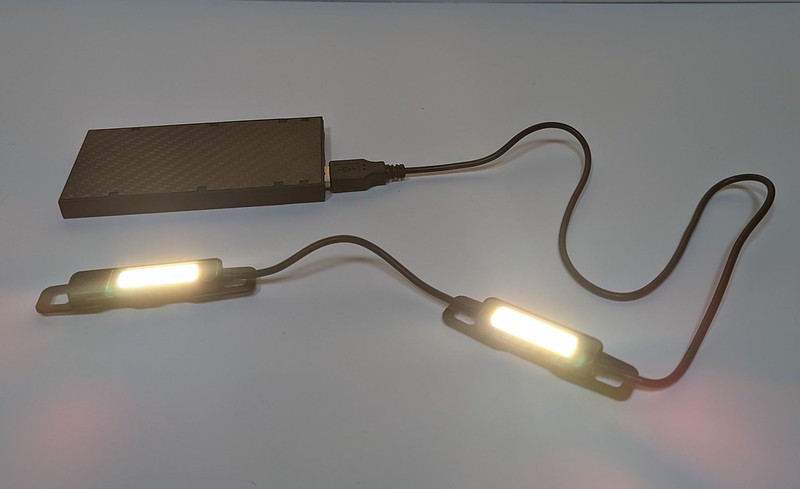
Skip to the commentary section at bottom to read my subjective notes on the Nitecore UT05.
Disclaimer: This light was provided free of charge by Nitecore Store, shipping direct from their Texas location. I received the UT05 on June 13, 2022 and prepared this review over about 6 weeks of testing and real-world use. (I do regret that this review did take much longer to get prepared and published than I committed to.) The light can be purchased through Nitecore Store (U.S.) for $35.95 at time of this review.
Unboxing
The UT05 in retail box arrived via a padded shipping mailer. The front of the retail box features the 400 lumen max output rating, an image of a runner, and of course, the UT05 itself.

The left side shows the specifications while the right side advertises that it is best used with Nitecore's running belt and power bank.


The rear of the box lists the full gamut of features offered by the UT05.
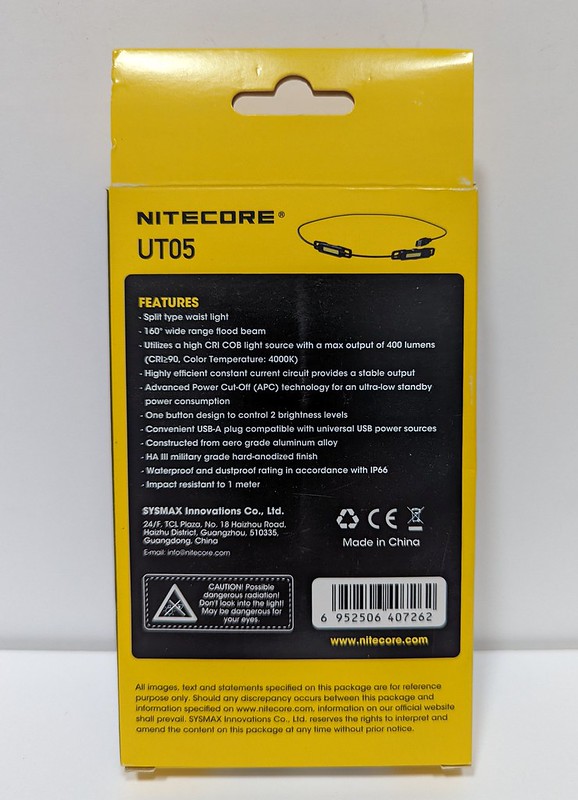
In the box Nitecore includes the UT05, a USB cable fastener designed specifically for use with the NB10000 power bank, 4 hook and loop straps, an instruction sheet in 11 languages, and a registration card.

The user manual is also available online here:
Nitecore backs the UT05 with a 5 year warranty – the same as it offers with regular flashlights.
Design
There are few lights advertised as "running lights" that aren't either headlamps or safety armbands. The UT05's lightweight design with two COB lights on one USB cable, designed to be attached to a belt, is thus like none other.
Nitecore lists the length at 29.5 inches long (for the entire UT05 assembly), 0.71" wide, and 0.33" high. I measured it at 29.5" long (or 30.0" including the full USB-A connector), 0.70" wide, and 0.39" high (including the hook-and-loop hook surface on the rear of the lights). The UT05 is a very compact package.
The two light modules are of different sizes as the one farthest from the USB connector is slightly larger to accommodate the power button. The sections measure 2.87" long without button and 3.45" with button. There is approximately 4.6" of wire between the two light sections.
Nitecore specifies that the UT05 weighs 40.4g (1.43oz). I measured 41g (1.5oz), right in line with specifications.
The two light modules have HA III hard-anodized aluminum bodies with sculpted sides. There are extensions on each that provide a surface for mounting, whether with straps to a belt or a hook on a wall. The branding and model number are on the side of the first light module while the serial number is on the other.

By having two sections of illumination instead of just one, it allows the light to conform to the wearer's body comfortably when worn on a belt or waistband and provide extra wide-angle coverage.
As seen with most COB lights, the illumination surface is yellow and flat. (Note: the UT05 ships with protective film installed; be sure to remove this before use!) The single switch is a flat button located on the front of the light farthest from the USB connector. It is easy to find and has a solid click when pressed.

When on, a 2x8 array can faintly be seen. (Note: the camera is able to capture this much better than the human eye.)
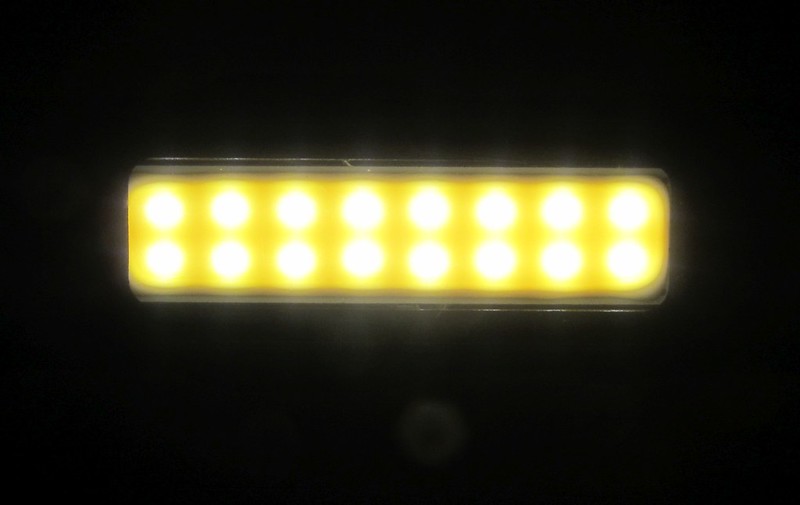
On the back side, opposite the COB lights, are hook-and-loop fasteners. Specifically, this is the hook side of hook-and-loop (think "Velcro"), so the UT05 can be attached to belts, packs, or other items with the loop style fastener (or a generally "fuzzy" surface).

Accessories
USB Cable Fastener
While the UT05 can be used with any USB source rated at 1A or higher, Nitecore designed the UT05 to use the Nitecore NB10000 power bank – so a custom-fitting cable strap designed for the NB10000 is included. This strap has a plastic piece that locks onto the UT05's USB connector and a rubber band that securely wraps around the NB10000 – thus keeping the USB cable from being pulled out by accident. This was a smart thing to include, giving piece of mind that the cable won't come loose accidentally while bouncing around during a run.


Hook and Loop Straps
While the UT05 has hook-and-loop style hook fasteners on the back, Nitecore expects some users will not have belts ready with mating loop surfaces. For this reason, four (4) thin hook-and-loop straps are included. These can be used to strap the UT05 to other belts or surfaces.
Performance
Beam
Being a COB-style light (chip-on-board; a type of light with multiple emitters on a single surface), there is no real "beam" to speak of in the usual sense. Rather, a wide area is illuminated as the light scatters in virtually all directions. Nitecore says this is 160 degrees, and that seems fair. As there are two separate sections to the UT05, nearly 360 degrees can be illuminated based on how the sections are arranged.

Tint & Temperature
Nitecore advertises the UT05 as 90+ CRI and 4000K color temperature. I found this to be accurate in testing. The 4000K color temperature is on the warm side of neutral, which generally is more pleasant than cooler color temperatures for most people.
High Color Rendering Index (CRI) means that the true colors of objects are shown; this useful for the given purpose of the UT05 as it enables a runner to not just see the shape of what's around them but the natural colors with clarity. This could help differentiate a stick from a snake, for example!
To demonstrate the overall color balance, here is the UT05 surrounded by lights with emitters of various tints and temperatures. Camera W/B set to daylight.
L to R: Convoy S2+ (XML 6500K), Nitecore UT05 (COB), Lumintop Tool AAA Cu (219B 4300K), BLF348 (219B 5000k).

Output
Nitecore rates the UT05 at 400 lumens on High and 200 lumens on low.
I measured 337 lumens at turn-on and 329 lumens at 30 seconds on High. The metal light bodies got as warm as 129F (54C) during testing; this is very warm to the touch but not uncomfortable to use.
I measured 189 lumens on Low; this remained stable from turn-on through the first minute measured. The metal light bodies got as warm as 96.5F (36C).
Ambient temperature was 74 F and the recommended Nitecore NB10000 power bank provided the power.
(While measured output was slightly less than specifications, it should be noted that my test rig is calibrated for typical flashlights, not COB-style lights. Therefore, my measurements should be considered approximate but imprecise.)
As the unit has no internal battery – and could be powered by as large or small of a power bank as desired – no runtime tests were performed. Power consumption was measured as noted below.
All outputs:
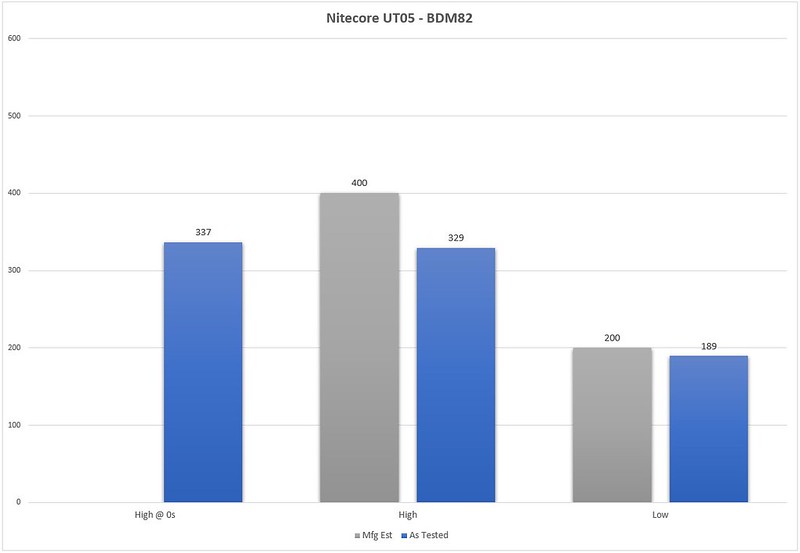
Amperage Draw
As measured with fully charged NB10000 power bank and an inline USB meter:
- High: 1.2A at turn on, dropping to 1.1A after
- Low: 0.55A at turn on, dropping to 0.51A after
Throw
I measured throw at 1.46 meters and the resulting candela on High was 326 Cd at 30 seconds - equivalent to 36 meters of throw. On Low, 182 candela or 27 meters of throw was measured.
Nitecore rates the UT05 at 185 candela and 27 meters of throw on High and 100 candela or 20 meters of throw on Low, so my throw measurements were a little higher than specifications despite lumen output measured being slightly less than specified.
PWM
Nitecore advertises the UT05 is PWM free and I was not able to detect any Pulse Width Modulation visually or using a camera's CMOS sensor. (PWM is a way of lowering total light output by briefly pulsing the power to the LED. This can make the light appear to flash particularly while in motion, so PWM is not desired.)
Parasitic Drain
Nitecore promotes the UT05 having "Advanced Power Cut-off (APC) technology for an ultra-low standby power consumption." I wasn't able to test this with a precise multimeter as I would with typical flashlights/batteries, but using a simple inline USB meter, it registered 0.00A. Thus, it is safe to say that the parasitic drain (the amount of power it draws when plugged in but not in use) is extremely low.
Low Voltage Battery Protection
Nitecore doesn't mention what happens when battery voltage is low, but I found that the UT05 simply does not turn on or will power off if the power bank is not able to provide enough power. While Nitecore states that the UT05 requires a USB power source with 5V/1A or above output, I found that the UT05 will power on (but only operate on Low) with a 5V/0.5A source.
Impact Resistance
Nitecore rates the UT05's impact resistance at 1 meter, and the UT05 did survive my 1 meter drops unscathed.
Interface
The interface is easy to use, given the single button and only two outputs.
From off:
Long press to turn on the light.
From on:
- Long press to turn off.
- Short press to cycle from Low to High.
Output mode is not memorized. The UT05 always powers on in Low mode. If the power source cannot supply adequate power for High to operate, the UT05 will power off when attempting to switch from Low to High.
Beamshots
Camera locked to settings most similarly recreating what I see with human eye. Canon SD4000IS, ¼", F2.0, Daylight WB, ISO800.
Control shot (looking down two levels of retaining wall with grass in foreground, landscaping rock in distance, and trees between retaining walls and landscaping rock):

Low:
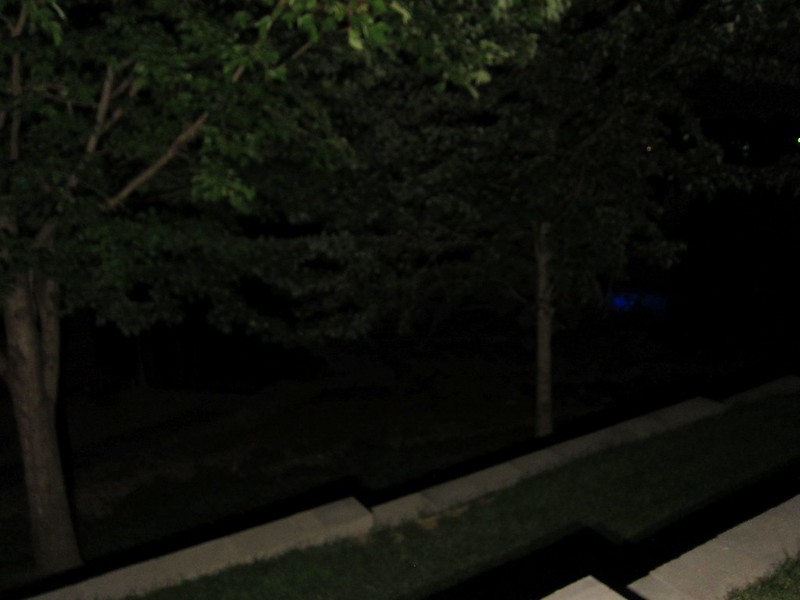
High:

Control shot (Looking down on a walkway and yard with a boat in the distance at approximately 85 feet):

Low:
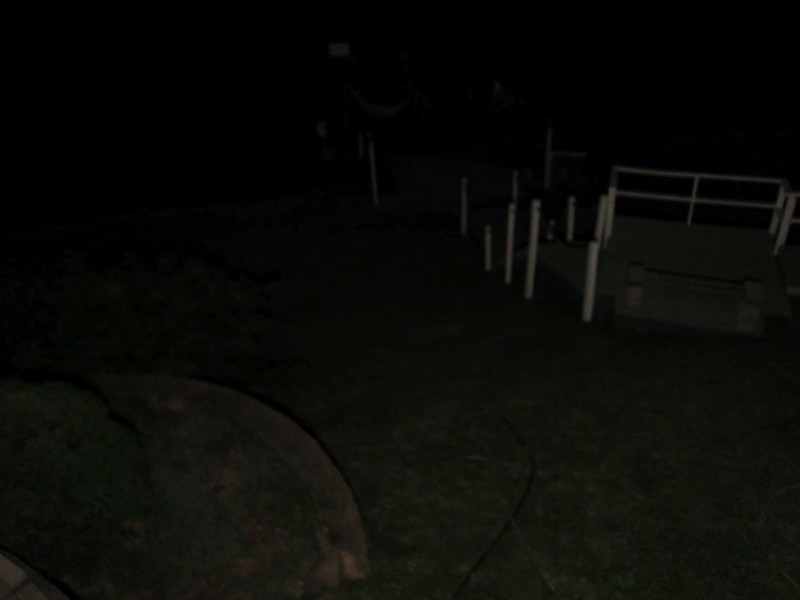
High:

Notice how clear and natural the colors appear in the photos above, thanks to the high CRI. To illustrate the color reproduction – and the many possible uses for the UT05, here's a photo taken inside my cargo trailer. Note how the orange, red, blue, black, silver, and brown shades appear natural and not washed-out.

Problems
No problems were experienced with the Nitecore UT05 while testing.
Commentary
The UT05 is a rather innovative product. There are many COB lights on the market, but this is the first one I've seen designed anything like this. Such a design offers a few unique advantages.
First, the extremely small yet versatile design takes up little space and allows it to be used in a wide variety of ways. It can be dropped down into a tight engine bay. It can slide under a stove or washing machine. It can be hung, strapped, or screwed to about anything you'd like.
Second, the use of an external power source gives it a very long runtime – and it can be made virtually endless if power banks are swapped or plugged into either main or automotive power.
Finally, for runners, the waist light design means there's no bouncing headlamp or narrow beam to deal with; the UT05 lights up a wide area all around the runner – and with excellent color rendition and a pleasant color temperature.
There are some potential negatives/cons to this design; the impact of these will likely vary by user.
First, the fact that an external power source is not included may be a letdown – especially since the NB10000 is neither particularly inexpensive or small. It would be nice if a smaller form-factor power option was available that would be more convenient to pack and run with.
Second, while I generally liked the wide area being illuminated by the UT05, I noticed that my arms would be illuminated while jogging – which my peripheral vision kept picking up. That might sound silly, but it was something to adjust to as a headlamp keeps the light focused forward and won't do this (typically).
Overall I think the UT05 is a very neat niche product for a relatively low price. The simple but well-built design can be used in a plethora of ways – including the intended purpose of running.
Lux Meter: Dr. Meter LX1330B
Integrating "sphere": Homebuilt tube-style device calibrated on other known lights and test results. Numbers should be considered relative to each other and my other review figures but accuracy is in no way certified or guaranteed.
Camera: Canon SD4000IS
Micrometer: Mitutoyo CD-6ASX
All measurements and representations are in made in good faith but are not guaranteed accurate.